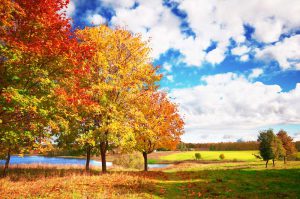
Chlorophyll, located in each cell of a plant’s leaves, gives leaves their green color. This chemical reacts with water, carbon dioxide and sunlight to create the food plants need to grow and thrive. During warmer temperatures, plants’ leaves contain an abundant supply of chlorophyll. As fall approaches, chlorophyll production decreases, causing leaves to turn shades of yellow, red or orange.
The combination of stopped chlorophyll production, less sunlight and cool temperatures triggers the plants and trees to stop growing and producing food. Once this occurs, the plants and trees release their leaves and they fall to the ground.
Evergreens are a different story. Their needles are covered with a heavy wax coating to help prevent moisture loss and the fluids inside the cells contain substances resistant to freezing. Evergreen leaves can live for several years, through all four seasons, before they are dropped and replaced by new growth.
As we head into fall, leaves will start to drop at varying rates. When leaves fall off trees, it may appear they have died. But, in actuality, the trees and plants are protecting themselves so they bloom again in the spring.
During the fall season we run supplemental crews to address leaves that have fallen on your property. Please keep in mind that for safety reasons, we can only carry so much in our trucks and trailers. Many times the amount of leaves on a property far surpasses the capacity of our vehicles. In these cases, the crews rake/blow the leaves into piles and call in for an additional pick-up later that day or the next day. If we have left a pile in a place that is not acceptable to you, or you have a pile that has been on site for more than two days, please do not hesitate to call us and we will address immediately.